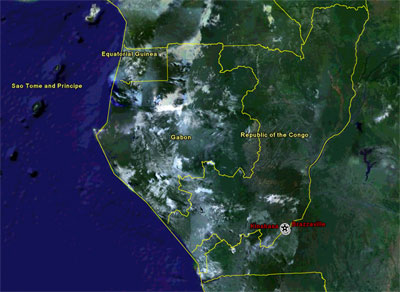GABON
Please note, this page is not longer being updated. For more recent information, please see news.mongabay.com and use the search function to find the country feed. For more up-to-date data on forest cover and loss, check out Global Forest Watch.
| Gabon Forest Figures
Forest Cover Total forest area: 21,775,000 ha % of land area: 84.5% Primary forest cover: n/a % of land area: n/a % total forest area: n/a Deforestation Rates, 2000-2005 Annual change in forest cover: -10,200 ha Annual deforestation rate: n/a Change in defor. rate since '90s: 1.5% Total forest loss since 1990: -152,000 ha Total forest loss since 1990:-0.7% Primary or "Old-growth" forests Annual loss of primary forests: n/a Annual deforestation rate: n/a Change in deforestation rate since '90s: n/a Primary forest loss since 1990: n/a Primary forest loss since 1990:n/a Forest Classification Public: n/a Private: n/a Other: n/a Use Production: n/a Protection: n/a Conservation: n/a Social services: n/a Multiple purpose: n/a None or unknown: n/a Forest Area Breakdown Total area: 21,775,000 ha Primary: n/a Modified natural: n/a Semi-natural: n/a Production plantation: 36,000 ha Production plantation: n/a Plantations Plantations, 2005: 36,000 ha % of total forest cover: 0.2% Annual change rate (00-05): n/a Carbon storage Above-ground biomass: 5,971 M t Below-ground biomass: 1,314 M t Area annually affected by Fire: n/a Insects: n/a Diseases: n/a Number of tree species in IUCN red list Number of native tree species: n/a Critically endangered: 3 Endangered: 6 Vulnerable: 59 Wood removal 2005 Industrial roundwood: 3,600,000 m3 o.b. Wood fuel: 627,000 m3 o.b. Value of forest products, 2005 Industrial roundwood: n/a Wood fuel: n/a Non-wood forest products (NWFPs): n/a Total Value: n/a More forest statistics for Gabon |
Primary forest makes up a little less than 40 percent of Gabon's forests. Unlike rainforests of Southeast Asia and the Amazon, Gabon's rainforests are drier and somewhat seasonal. Some deciduous trees are present.
In September 2002, at the World Summit in Johannesburg, Gabon announced the establishment of its first national park system consisting of a network of 13 parks that would cover 10 percent of the country's lands mass—10,000 square miles (25,900 sq. kilometers). Previously, Gabon lacked a park system and "protected areas" were sometimes open to logging. Less than 1 percent of Gabon was truly protected under the old system.
In 2002 the government also moved to cancel some logging concessions that had been granted in pristine forest areas.
Despite these positive developments, Gabon's forests still face an uncertain future.
Gabon is Africa's third richest country in terms of income per person, thanks to its relatively small and urbanized population, and its abundant natural resources—especially oil. About one-third of government revenue comes from offshore oil deposits. This heavy reliance on petroleum means that Gabon is highly sensitive to fluctuations in oil prices. In an effort to diversify its economy and reduce its dependence on energy exports, Gabon is looking towards agriculture, forestry, and tourism as additional sources of income. In the late 1990s, when oil prices dropped steeply and Asian demand for timber products fell sharply, the cash-strapped Gabonese government granted large logging concessions—this was because it had to continue making payments on its unusually high national debt but couldn't qualify for debt relief since its per capita income is relatively high compared to the rest of sub-Saharan Africa. By November 1997, more than 100 logging companies, most of them European, were operating in the country and exporting raw logs—the least valuable forest product from a tax-revenue standpoint.
Of even greater concern to conservationists is the construction of logging roads, which open interior forest areas to exploitation by colonists, poachers, oil companies, and gold miners. Cheap weapons, abundant wildlife, and soaring cross-border demand for wildlife products mean that poaching is increasingly a problem in Gabon despite new legislation enacted to control the trade. Gabon is now a major source of bush meat for urban centers in Central Africa. "Pygmies"—short-statured forest people who have a wealth of knowledge about local wildlife—are sometimes hired as hunting guides.
The Gabonese government knows it will have to stem these activities that are at odds with what it believes holds the most promise for future: eco-tourism. With its unmatched wildlife, long coastline with ample sport-fishing potential, and stable political environment, Gabon could become the "Costa Rica" of tropical Africa within a generation. The newly established park system is simply the first step in such a development. With its oil supplies dwindling, now is the time for Gabon to recognize the value of its ecosystems.
Pictures of Gabon
Recent articles | Gabon news updates | XML
Suggested reading - Books
- Last Place on Earth
- Gabon, Sao Tome & Principe: The Bradt Travel Guide
- Gabon and Equatorial Guinea Map
Unless otherwise specified, this article was written by Rhett A. Butler [Bibliographic citation for this page]
Other resources
Contact me if you have suggestions on other rainforest-related environmental sites and resources for this country.

Image copyright Google Earth, MDA EarthSet, DigitalGlobe 2005
CIA-World Factbook Profile
FAO-Forestry Profile
Last updated: 4 Feb 2006
